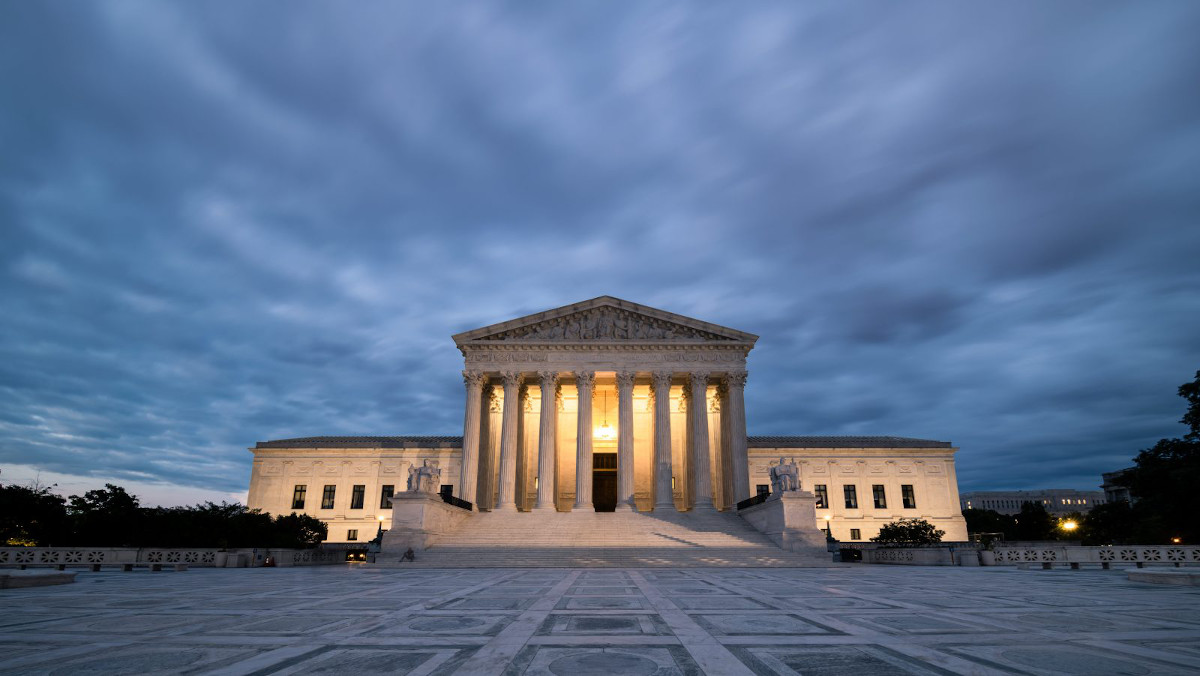Soon after taking office, President Joe Biden announced a plan to cut emissions in half by the end of this decade. So far, conservative members of his own party have been the biggest obstacle to achieving progress on climate change. Senator Joe Manchin of West Virginia, one of two crucial Democratic swing votes in the Senate, succeeded in removing the most aggressive climate policy from Biden’s Build Back Better Act, which is still being negotiated.
But a greater obstacle looms on the treacherous path to reining in greenhouse gas emissions, one that the White House won’t be able to negotiate with: the Supreme Court.
Under former president Donald Trump, the Republican-controlled Senate confirmed three conservative justices to the Supreme Court, ensuring a conservative supermajority for decades to come (unless Democrats pass a law to expand the number of seats on the bench). The effect of the court’s new ideological makeup on climate policy will be put to the test next year.
Last week, the Supreme Court agreed to review the scope of the Environmental Protection Agency’s authority to regulate carbon emissions from power plants. The United States’ fossil-fuel powered plants produce about a third of its energy-related emissions. In 2007, the Supreme Court ruled that the EPA is required to regulate greenhouse gases under the Clean Air Act. Now, the manner in which the agency wields that authority, and possibly even the portion of the Clean Air Act that grants the EPA the power to regulate emissions, will be under scrutiny from the court.
In order to understand what the Supreme Court could do to Biden’s climate agenda, we need to go back to something that happened under former president Donald Trump. In 2017, Trump directed his EPA to review former president Barack Obama’s Clean Power Plan, finalized in 2015, which sought to cut emissions from the power sector 32 percent by 2030. It took Trump’s EPA two more years to complete its alternative to the Clean Power Plan, a coal-friendly proposal called the Affordable Clean Energy rule that would have reduced emissions from the power sector just 0.7 to 1.5 percent by 2030. The rule offered suggestions for how power plants could become more efficient, but didn’t impose any specific limits on emissions or require electric utilities and power plant operators to shift to renewable energy.
On the last full day of Trump’s term, a divided three-judge panel on the U.S. Court of Appeals for the District of Columbia Circuit tossed Trump’s rule and sent it back to the EPA, soon to be staffed by Biden appointees, to redo it from scratch. Trump’s EPA, the court said, had devised its new rule through a “tortured series of misreadings” of the Clean Air Act.
But the Supreme Court may now decide that those series of misreadings aren’t so tortured after all. Last Friday, the Court announced it will review four petitions filed by two Republican-led states and two coal companies. The petitioners are appealing the D.C. Circuit Court’s ruling and asking the Supreme Court to limit the EPA’s power to regulate emissions.
“How we respond to climate change is a pressing issue for our nation, yet some of the paths forward carry serious and disproportionate costs for states and countless other affected parties,” a brief filed by the attorney general of West Virginia, one of the states petitioning the Supreme Court, stated. “The court should intervene now.”
The Supreme Court’s decision to review the petitions baffled onlookers. The Biden administration asked the court to wait to review the case until it had proposed a rule to replace Trump’s Affordable Clean Energy rule. The court is going ahead with the review anyway, which means it won’t have a new rule from the Biden administration to consider. “It’s extremely surprising,” Michael Gerrard, professor of environmental law at Columbia Law School and founder of Columbia University’s Sabin Center for Climate Change Law, told Grist.
Legal experts say there are likely two ways the review, which is expected to take place over the course of next spring and summer, could go.
Option one: The Supreme Court will invoke the “major questions doctrine,” which is a tool for how courts interpret and review statutes such as the Clean Air Act. The doctrine states that where a rule will have “vast economic and political significance,” courts shouldn’t defer to an agency’s interpretation of that rule and should ensure that Congress has “spoken clearly” about its intent to allow the agency to make the rule.
The major question at hand is “What’s the role of EPA in regulating coal-fired power plants?” Gerrard said. “Or, even more broadly, what’s the role of the EPA in regulating the energy system?” That’s such a huge question that it requires Congress to “speak clearly” to it before an agency can start regulating it.
Section 111(d) of the Clean Air Act directs EPA to establish emissions standards for stationary sources of air pollution that “may reasonably be anticipated to endanger public health or welfare,” such as coal plants. And it says the agency should do so through the “best system of emission reduction.” But what qualifies as the “best system”? Section 111(d) doesn’t say.
Trump’s EPA argued that Section 111(d) required the agency to only regulate greenhouse gas emissions right at their source by, for instance, requiring a coal plant to add carbon capture technology so that its emissions don’t float into the atmosphere. Requiring that kind of targeted intervention is called “regulating in the fenceline.”
The D.C. District Court disagreed, ruling that EPA doesn’t have to take such a narrow approach to regulating emissions. That ruling left the door open for the agency to take a more holistic approach to greenhouse emissions by imposing measures “outside of the fenceline,” such as potentially requiring electric utilities to include renewables in their power mix. That’s what Obama’s Clean Power Plan essentially did by requiring states to create their own plans to green their electricity mix. The Supreme Court blocked Obama’s plan not long after it was introduced in 2016 by putting a temporary stay on it before a federal appeals court could even review it — an unprecedented development. At the time, the court said the plan couldn’t move forward until all legal arguments had been heard, preventing the plan from being enforced.
The Supreme Court will now review the D.C. District Court’s decision to toss Trump’s rule. If the Court sides with the petitioners — West Virginia, North Dakota, the North American Coal Corporation, and Westmoreland Mining Holdings — its ruling would limit the Biden administration’s efforts to rein in greenhouse gas emissions from industry in a systemic way.
“Section 111(d) is one of the most important tools under existing statutes to control emissions from coal-fired power plants,” Gerrard said. “There’s a concern that EPA may take that tool out of the toolbox. There’s also a concern that the Supreme Court might go even further in reducing EPA’s powers.”
That brings us to option two. The court may opt to look at the case through the “nondelegation doctrine” lens. The nondelegation doctrine says that laws violate the separation of powers when they delegate authority that should belong to Congress to an administrative agency (in this case, the EPA) without adequate guidance. The idea is that Section 111(d) of the Clean Air Act itself fails to give enough direction to the EPA. In other words, the issue at hand in this scenario is not what kind of authority EPA has over power plant emissions, but whether the statute that gives EPA that authority in the first place is even valid. If the Supreme Court goes after Section 111(d) directly, then Biden’s EPA may not have statutory authority to enact its own Clean Power Plan or otherwise regulate emissions from power plants.
Michael Burger, executive director of the Sabin Center for Climate Change Law, said that the chances of the Supreme Court pursuing this course of action are slim, because it would set a legal precedent that could undermine the way Congress delegates power to federal agencies. “It is an outside chance,” he said. It’s far more likely that the court will require EPA to regulate in the fenceline instead of making rules that would force electric utilities to shift to greener sources of energy. Or the court could affirm the D.C. Circuit’s position, which was that Section 111(d) does not require the EPA to limit its authority to the fenceline. The first outcome would close the door on sweeping emissions regulations for U.S. power plants, while the other would illuminate a path forward for the Biden administration to introduce a Clean Power Plan 2.0.
“In my view, the question of how EPA can exert authority over greenhouse gas emissions is what’s at stake in the case,” Burger said. “The question of whether EPA can exert authority over greenhouse gas emissions may come up, but let’s hope it doesn’t.”



